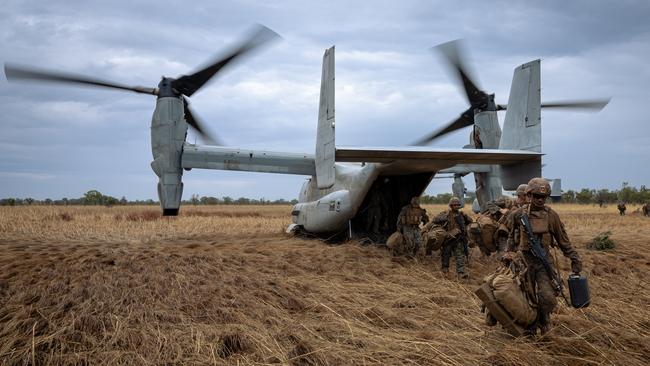NT joint exercises essential for maintaining combat readiness
The MV-22B Ospreys of the current US Marine Rotational Force – Darwin (MRF-D 24-3) proved their unique capabilities in two major multilateral exercises across Australia’s north in July.

The MV-22B Ospreys of the current US Marine Rotational Force – Darwin (MRF-D 24-3) proved their unique capabilities in the simultaneous support of two major multilateral exercises across Australia’s north in July.
The two exercises – the littoral-focused Exercise Predator’s and the Pitch Black air combat training event – tested the Marines’ ability to operate simultaneously from the decks of warships and from remote land bases.
The tilt-rotor Bell-Boeing Osprey is able to take off and land vertically like a helicopter, but it also able to fly at the higher speeds of fixed-wing transport aircraft and has become the keystone of the Marines’ medium airlift capability. The 10 aircraft in the current rotation belonged to Marine Medium Tiltrotor (VMM) Squadron 268, the “Red Dragons”, normally based at Kaneohe Bay in Hawaii.
Based in Darwin for the duration of MRF-D 24-3’s tenure, the Ospreys represent the Aviation Combat Element of the larger Marine Air Ground Task Force.
The major land training supported by the Ospreys in July was Exercise Predator’s Run 24, which was led by the Australian Army’s 1st Brigade and also involved the UK, US and The Philippines. Predator’s Run 24 had a littoral focus and was held at multiple sites across the Northern Territory and Melville Island.
“This exercise will test our flexibility and adaptability in a complex but controlled environment to execute the core mission of a VMM squadron in a medium threat environment while based out of an expeditionary site,” commanding officer of VMM-268, Lieutenant Colonel Brandon Pope explained at the beginning of Predator’s Run.
“Our ability to provide assault support to the MAGTF and the joint force relies on our capacity to integrate in all phases of the operation.”
Colonel Pope said that one of the key aspects of the integration was the opportunity to work with 40 Commando of the Royal Marines and the Royal Navy’s support ships HMS Argus and HMS Lyme Bay.
“We’re supporting Predator’s Run simultaneously (with Pitch Black) and today I have four aircraft performing an insertion on the land side, working with the Australian Defence Force; and I have another flying out to the Lyme Bay to support 40 Commando off the ship,” Colonel Pope added.
The maritime support work was also carried out alongside the Royal Marines’ Merlin transport helicopters, in a further demonstration of integration and interoperability.
“We have Merlins and Ospreys working side by side, flying to the same objective. I also have four aircraft operating at Gove – which is about 350 nautical miles east of Darwin – and the crews are actually living in tents next to their aircraft,” Colonel Pope said.
During Exercise Pitch Black – a large force employment exercise which involved around 150 aircraft and 20 nations – VMM-268’s Ospreys worked within the Mt Bundey and Bradshaw Field Training Areas in the NT, as well as flying from the deck of the Italian navy’s aircraft carrier ITS Cavour.
“One of the key objectives of Pitch Black for us is the opportunity to work with the Italians, operating off Cavour,” Colonel Pope said.
“We have an activity planned where we’ll conduct a personnel recovery rehearsal with Italian navy helicopters and with international fixed wing support.”
Colonel Pope said his squadron would significantly benefit from its support for two large-scale exercises at the same time.
“I need to practise being in multiple places at multiple times, so it is a great opportunity for us to be here in the Northern Territory,” he said. “The Top End is a phenomenal training area and it’s great for us to test our ability to actually perform the expeditionary basing operations that we pride ourselves in being fairly good at.”



To join the conversation, please log in. Don't have an account? Register
Join the conversation, you are commenting as Logout